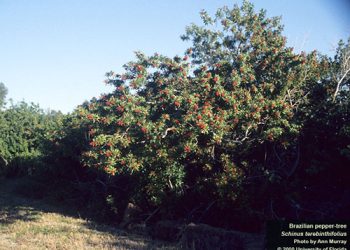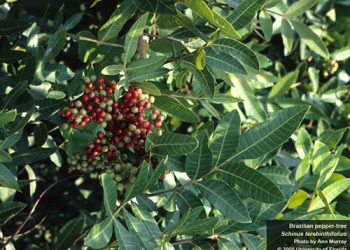Brazilian Peppertree
Origin:
South America (Argentina, Brazil, Paraguay)
Introduction to Florida:
Imported in the late 1890s and later in 1926 as a landscape ornamental
Stage on Invasion Curve:
Long-term management
Description
Brazilian peppertree is an evergreen shrub or tree with shiny green alternate compound leaves, white flowers, and small clusters of bright red fruits. The multi-stemmed crossing branches often form an arching impenetrable thicket. Two genetic types of Brazilian peppertree have hybridized in Florida. These hybrid trees have higher survival and growth rates than the native South American trees.


Impacts
Brazilian peppertree forms a dense canopy that shades out native plants in developed areas and natural areas. It also produces allelopathic chemicals in the soil, which prevent other plants from growing. It displaces rare and endangered plants and encroaches on nesting habitat of the threatened gopher tortoise. Brazilian peppertree is a host for an invasive species of root weevil that damages Florida’s citrus trees. In addition, it may cause a rash in some sensitive people.
Where to Find Them
Brazilian peppertrees invade disturbed sites such as highway rights-of- way and fallow fields. They also can be found in natural areas, including drained bald cypress stands, pinelands, hardwood hammocks, and mangrove forests.
Distribution Maps
What You Can Do
- Remove seedlings by hand pulling or herbicide treatment
- Use cut stump treatment for large multi-stem shrubs
- Plant comparable native shrub species such as varnish leaf (Dodonaea viscosa), elderberry (Sambucus canadensis), or seagrape (Coccoloba uvifera)
Report Brazilian peppertree in natural areas on IveGot1.org or using the IveGot1 reporting app.
More Information
Publications
- Brazilian peppertree: a poster child for invasive plants in Florida landscapes (Journal of Florida Studies)
- Identification and Biology of Nonnative Plants in Florida’s Natural Areas (UF)
- Help Protect Florida’s Natural Areas from Non-Native Invasive Plants (UF)
- Explore your AlterNatives (FLEPPC)
- Brazilian Peppertree Management Plan (FLEPPC)






